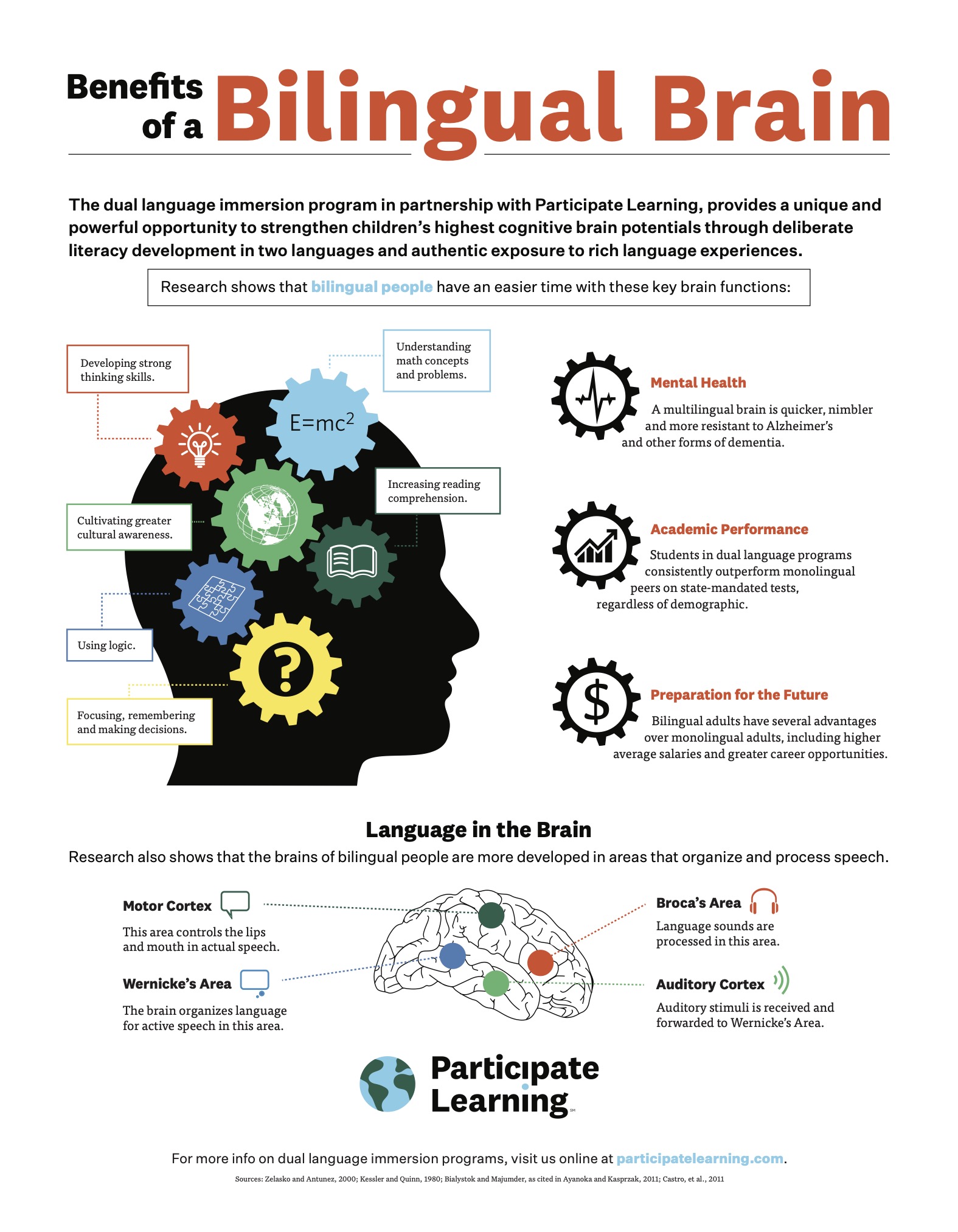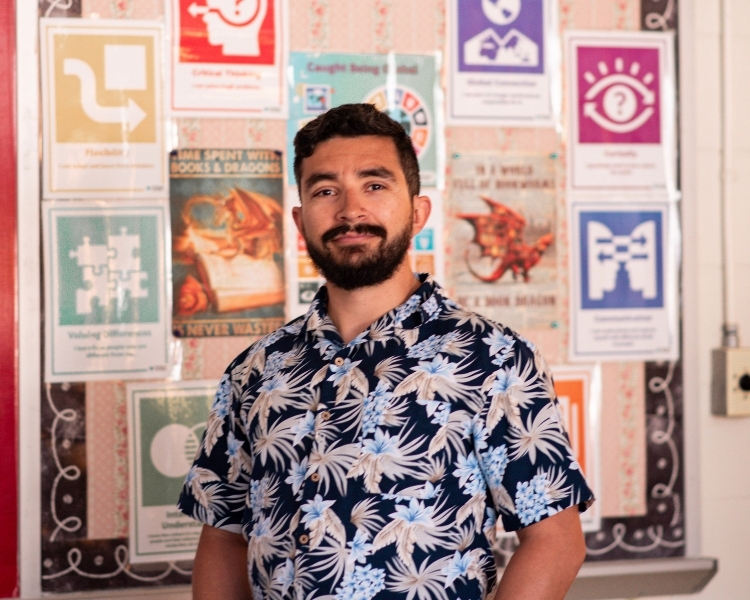Did you know that learning a second language can physically reshape your brain? Studies show that bilingualism strengthens neural connections, enhances cognitive flexibility, and even delays cognitive decline. But its benefits don’t stop there.
Bilingual students often outperform their peers academically and have a competitive edge in today’s job market. They are better prepared to collaborate, solve complex problems, and lead with confidence.
Let’s explore how bilingualism transforms the mind and leads to lifelong success.
How Learning a Second Language Rewires the Brain
Learning a new language is like a full-body workout for your brain. When you acquire a second language, your brain physically changes, strengthening key areas responsible for communication and cognitive function. Research shows the brains of bilingual people are more developed in these areas that organize and process speech:
- The motor cortex refines speech production, ensuring precise lip and mouth movement.
- Wernicke’s area helps the brain process spoken language.
- Broca’s area processes language sounds, enhancing pronunciation and fluency.
- The auditory cortex sharpens the ability to distinguish between different languages, improving listening skills.
Bilingualism also enhances memory, boosts multitasking skills, and strengthens executive function, which controls decision-making and problem-solving. Just as lifting weights builds muscle, practicing multiple languages strengthens neural pathways, increasing cognitive flexibility and resilience. Over time, these mental gains lead to sharper thinking, improved focus, and even a delayed onset of age-related cognitive decline.
Looking for an easy way to share the benefits of bilingualism? Our printable one-pager explains how a bilingual brain supports focus, memory, and cognitive growth on the path to lifelong success.
Bilingualism Improves Focus, Memory, and Brain Health
Extensive research in neuroscience and psychology demonstrates the cognitive benefits of bilingualism. Notably, a 2004 study by psychologists Ellen Bialystok and Michelle Martin-Rhee demonstrated that bilingual children outperform monolingual peers in tasks requiring attention and inhibition control, such as the Dimensional Change Card Sort task.
Bilingualism also enhances logical thinking, long-term memory, and adaptability. Regularly managing multiple languages strengthens executive functions, enabling individuals to switch between tasks efficiently and adapt to changing environments.
These cognitive benefits help set students up for success in the classroom and careers.
Academic Benefits: How Bilingualism Boosts Learning
Bilingual students often excel academically, benefiting from enhanced cognitive abilities that translate into classroom success. Research indicates that these students typically exhibit improved reading comprehension, stronger working memory, and superior problem-solving skills. These advantages stem from the mental flexibility required to navigate multiple languages, which enhances overall cognitive function.
Dual language immersion programs, where instruction is delivered in two languages, have been particularly effective in boosting academic performance. Students in these programs consistently outperform their monolingual peers on standardized tests and demonstrate higher overall academic achievement.
For example, kindergarten students in the dual language program at West Oxford Elementary experienced more academic growth on mid-year assessments than students not enrolled in the program. These insights and others underscore the profound academic benefits of bilingualism, illustrating how dual-language education can enhance learning outcomes and prepare students for a globally connected world.
The Social and Emotional Benefits of Being Bilingual
Bilingualism offers profound social and emotional advantages, building interpersonal skills and cultural awareness. By navigating multiple languages and cultures, bilingual individuals often develop higher levels of empathy, enabling them to understand and appreciate different perspectives. This heightened empathy fosters stronger social connections and adaptability in various social contexts.
Exposure to different cultures through language learning also enhances students’ understanding of the world, promoting sociocultural competence. This competence includes problem-solving, cognitive flexibility, tolerance for ambiguity, behavioral adaptability, and intercultural understanding, all of which are crucial for the modern workforce.
Bilingualism Supports Career Readiness in Students
In an interconnected economy, employers highly value candidates who can communicate in multiple languages, since they can engage with a broader network of colleagues and navigate multicultural environments.
Studies indicate that people who speak more than one language earn higher salaries and have more job opportunities than monolinguals. Since 2020, there has been a 30 percent increase in bilingual remote jobs, and nine out of 10 employers rely on employees who can speak languages other than English.
This applies to many sectors of the workforce, including business, healthcare, education, and government. Companies expanding into international markets seek employees who can bridge language barriers, facilitating smoother negotiations and operations.
With a variety of patient populations, healthcare providers require bilingual staff to ensure accurate communication and culturally competent care. Government agencies often require bilingual individuals to effectively serve communities and engage in international relations.
Promoting bilingualism from an early age benefits individuals and strengthens national economic standings. A workforce proficient in multiple languages attracts global businesses, fosters international partnerships, and enhances competitiveness in the global market. Speaking more than one language equips students with skills essential for thriving in a global job market, offering personal career advantages and contributing to broader economic growth.

Want a visual of these brain benefits as an easy reference? Download our free infographic.
How to Support Language Learning for a Stronger Brain
Developing bilingual skills takes time and practice, but the cognitive and career benefits are well worth the effort. One of the most effective ways to support language learning is through dual language programs, where students learn academic content in two languages, fostering fluency and cultural understanding. Immersion-based learning—surrounding yourself with the target language—can also accelerate proficiency.
For independent learning, language apps like Duolingo or Babbel and multilingual media (such as TV shows, books, and podcasts) provide accessible and engaging ways to practice. Interacting with native speakers through conversation groups or cultural exchanges deepens understanding and builds confidence.
Parents and educators can support bilingual learners by encouraging consistent practice at home and in the classroom. Create opportunities for authentic communication and provide resources in both languages. By fostering an environment where language learning is both valued and practiced, you’re helping to shape sharper minds and stronger futures.
A Bilingual Brain Has Lifelong Benefits
The benefits of being bilingual extend far beyond communication. Learning a second language strengthens the brain, enhances cognitive abilities, and improves academic performance. It also fosters empathy, increases cultural understanding, and prepares students to thrive in a global workforce. Bilingual individuals have a competitive edge in careers across all industries with skills that are increasingly in demand.
Considering starting a dual language program? Take our Dual Language Program Readiness Assessment to better understand your level of preparedness, and what to focus on next. No matter where you are in the process, Participate Learning is ready to help you empower young learners to become bilingual, biliterate, and globally competent.
Originally published on May 20, 2017.




